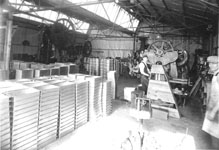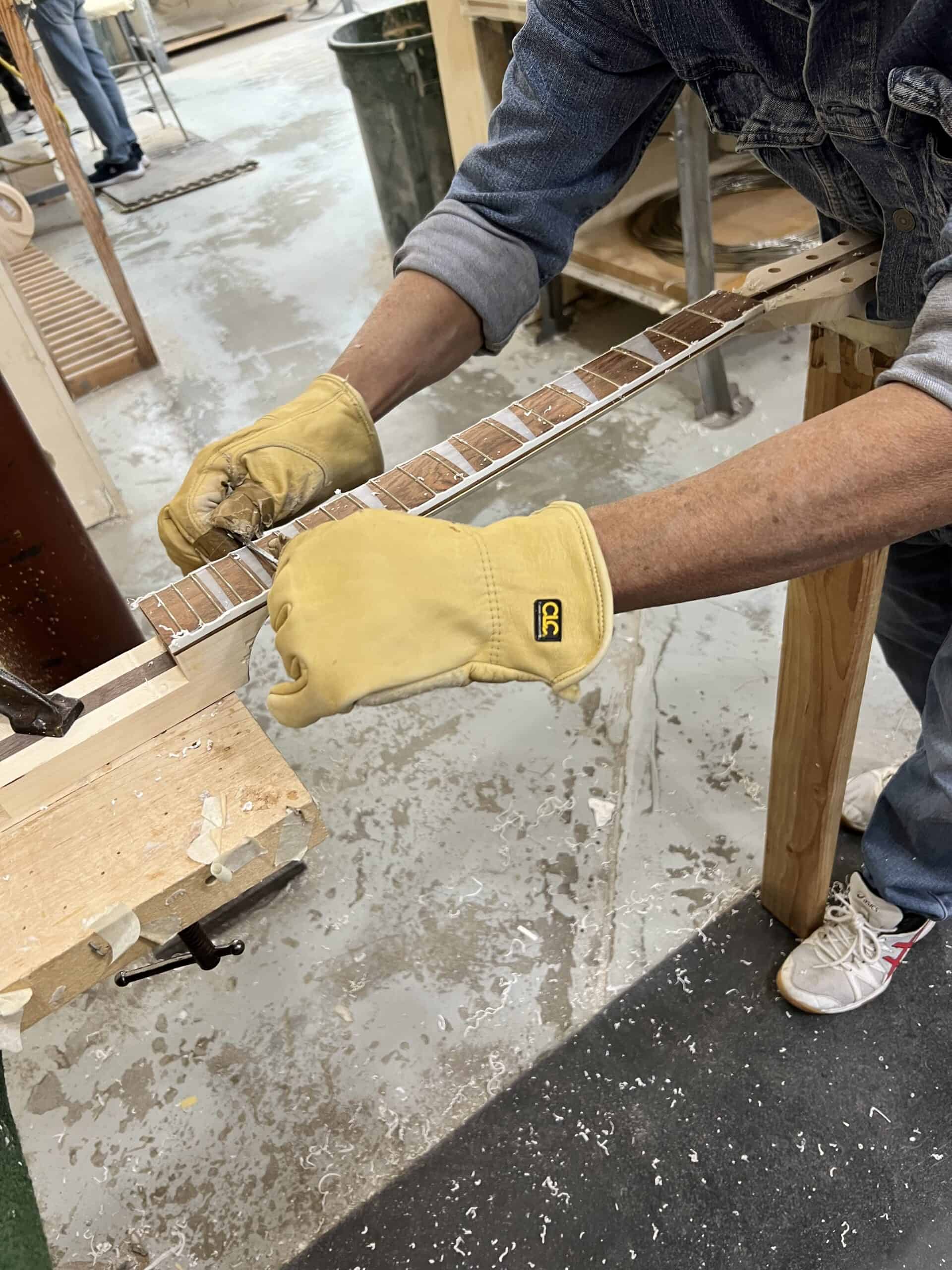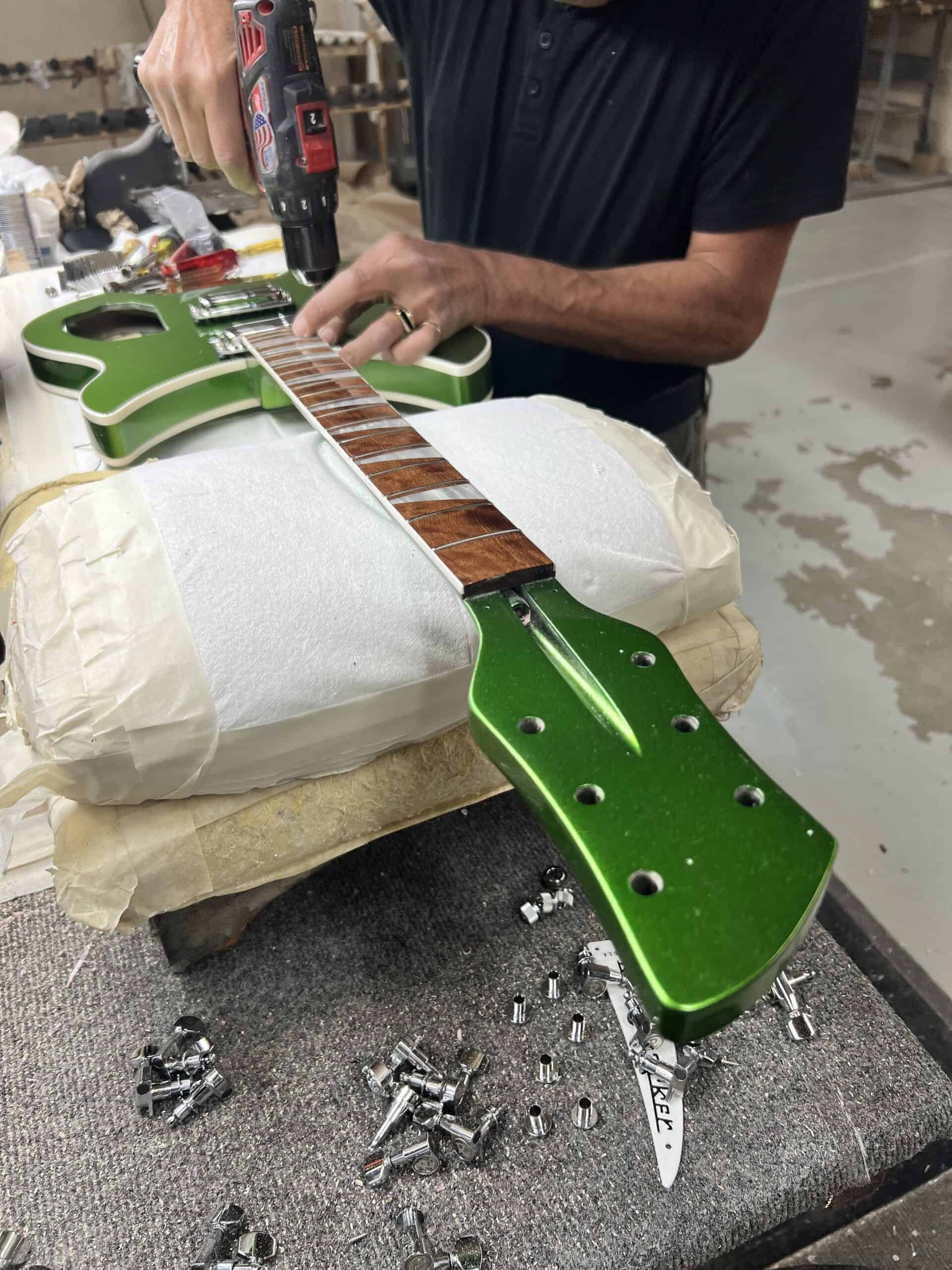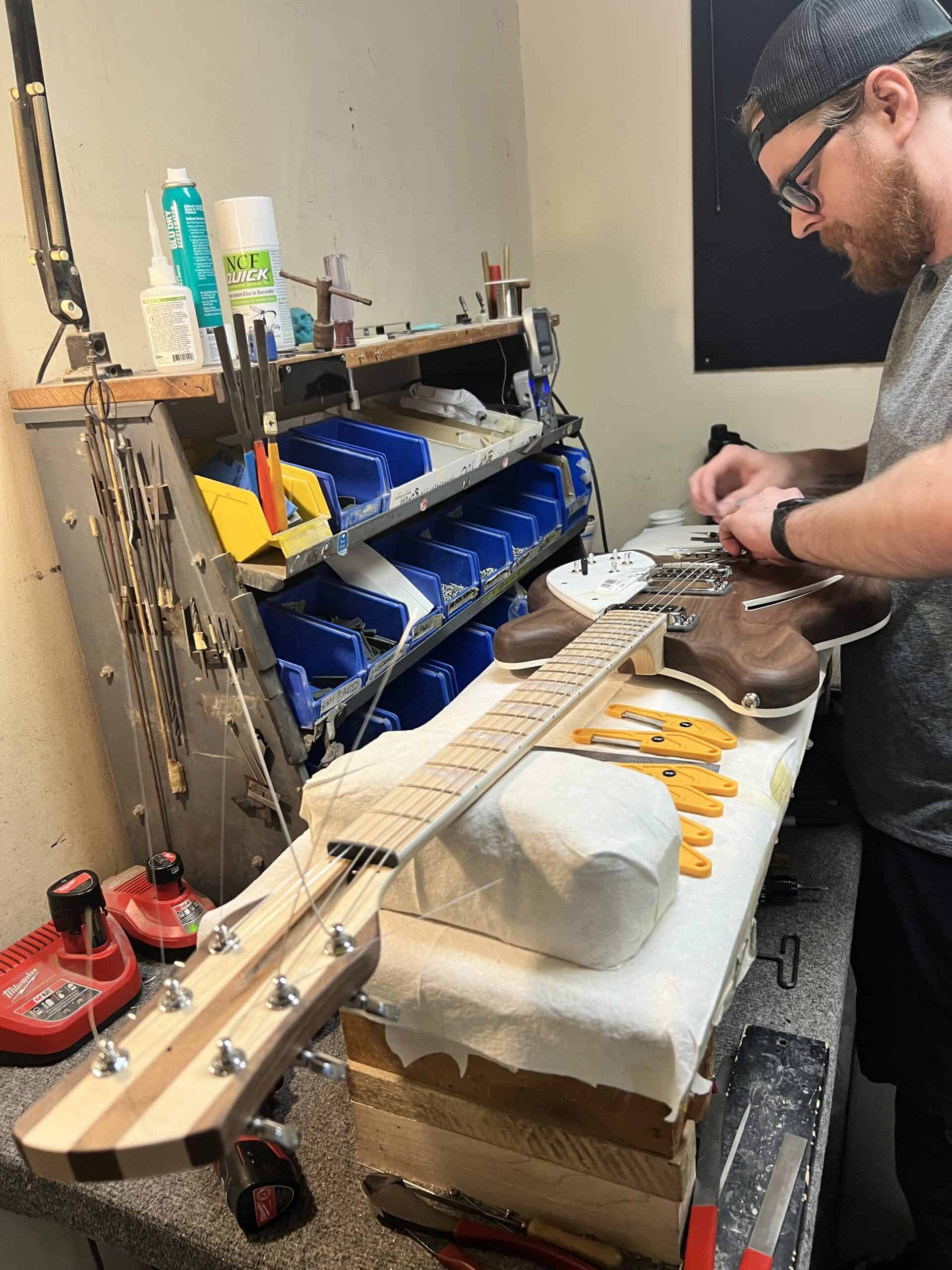Tour
Premiere Guitars’s Charles Saufley is On Location in Santa Ana, California, where he visits the Rickenbacker Guitars factory and headquarters. In this segment, Rickenbacker’s CEO/Chairman John Hall walks us through the process of building a Model 330 guitar and Model 4003 bass at their US Factory.

Wood
As one might expect, the creation of every Rickenbacker guitar begins in the wood shop. After a shipment of lumber is received, experienced woodworkers carefully inspect each piece of wood to ensure a proper match of grain and quality of material. Eastern hardrock Maple is our wood of choice for necks and bodies, while other woods such as walnut, vermilion and shedua are used for decorative details. Though some of our newer instruments sport maple fingerboards, our more traditional models have rosewood fingerboards.
Once numerous appearance matched timbers have been selected, they are cut on table saws to specific lengths for neck and body “blanks.” These body blanks are then sanded and prepared for cutting on automated CNC machines with their grain structure opposed for the greatest possible strength.
While many competitive necks are made of only two or three wood sections, Rickenbacker necks typically are made with a minimum of four, with some models having as many as eleven separate wood laminations. This provides the greatest strength and resistance to warping or twisting.
Once the neck and body blanks have been prepared, they are placed on sophisticated 3-axis CNC routers, which carve out both the instrument’s shapes, and some of the body cavities as well.
Once off the CNC Machine, it is time to attach the fingerboard to the neck and insert the frets. The most exacting techniques are employed in the insertion of frets into the Rosewood fingerboards by only the most experienced craftsmen. Each fingerboard presents a different challenge and only a skilled operator can decide the appropriate insertion force required for a particular unit. Seating frets accurately the first time makes the difference between an acceptable and a great instrument over the life of the product.
Binding, for the most part, is a lost art and is rarely attempted by most companies. Rickenbacker has perfected and continues the tradition of binding all deluxe models, which although very costly, produces a distinctive and memorable appearance.
Once the frets have been installed, it is time for the neck and body pieces to be given their final curves and contours. While this step is still done by hand on some models, many now undergo this transformation on the CNC machine.
Rickenbacker guitars, including the legendary 4000 Bass Series, have featured neck-through-body construction for many decades, at a time when other makers are just “discovering” this technique. While the primary benefit is great strength, the elimination of the neck to body joint or fastening device allows the string tension to be carried on one timber structure, leading to the highest level of natural sustain and clarity. Our hollow body instruments feature set-in necks, which in comparison to a bolt on neck, allows for a greater transfer of string energy through the instrument, as well as greater tone and sustain than you would have with a bolt on neck.
Finishing
Now that the neck and body have been joined, the guitar must be hand sanded before it goes into the paint room. This is a lengthy process that uses progressively finer sand-paper; all the curved edges as well as the flat surfaces are smoothed to an absolute, even finish.
Every portion of the instrument must be properly attended to, as the proprietary finish system used at RIC is very thin and unforgiving of any flaw. By starting with perfection, Rickenbacker can assure a perfect result. . . with a finish which will look great decades into the future.
In the paint room, no paint robots or hydro-static sprayers are to be found, only experienced craftsmen, dedicated to giving their undivided attention to each guitar. Before color can be applied, the instrument goes through an extensive sealing and sanding processes.
Once sanding and sealing have been completed, the artisan manually shades the color coats to the desired degree. Only those with an extremely sharp eye coupled with a steady hand can master this job producing the unique qualities, depth of shading and coloring.
Before the luxuriant layers of clear coat can be applied, the binding must be scraped with a knife edge to produce razor-sharp delineation between the binding and wood. At this stage, each element of the shading or color coat is examined and minute detailing is performed to assure perfection. No machine could possibly be so critical and painstaking as the workers who lavish their efforts upon each guitar at this stage.
Following many coats of sealer and color coats, numerous applications of a super high gloss finish are made. Providing not only great visual appeal, this surface treatment protects the guitar from dings and scrapes; the unique chemistry of the material makes it both hard and flexible at the same time. Impact areas do not craze or radiate, nor does this material turn cloudy or finish-check in cool weather like nitrocellulose.
Wet sanding is perhaps the most labor intensive investment made into any guitars produced today. Between the various coats, and especially prior to buffing, the coated surface must be leveled to insure smoothness and abraded to accept the next process. Specialized sandpaper and gear are coupled with great physical effort to produce the desired combination of evenness and lack of shine.
Sanding grits up to grade 1500 are necessary to caress the coating to perfect flatness. There is no surface of the guitar which escapes the attention of the wet sanding operator. Excess dust is removed by a special vacuum system and downdraft benches, where the air is filtered to remove any contamination.
Following wet sanding, the guitar is meticulously polished to the glass-like perfection for which RIC instruments are renowned. While most companies spend only fifteen minutes at this stage, Rickenbacker devotes over an hour and fifteen minutes carefully cutting, buffing and waxing to produce an unrivaled finish.
Assembly
Once a guitar has left the buffing department, it’s off to assembly. Rickenbacker has tooled its own parts since 1931 and, wherever possible, continues this practice to maintain control and ensure consistent precision. Most parts, with the notable exception of keywinds which are generally supplied by Gotoh, are produced in Rickenbacker’s own factory.
The assembly of electronics and parts is undertaken by skilled personnel. Each bridge and nut is hand set, to achieve accurate and precise intonation. The rest of the components are accurately placed to achieve optimum performance.
Only the finest American-made electronic components are used in the construction of Rickenbacker’s circuits. Switchcraft jacks and switches are standard, as are the custom-made CTS potentiometers.
Once assembled, each instrument passes through exhaustive inspections. Rickenbacker is proud of its set-up and testing procedures, resulting in the many compliments from musicians that the guitars are ready to play – straight from the case!







